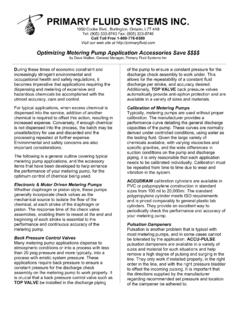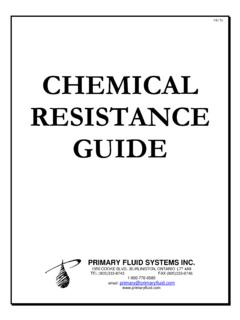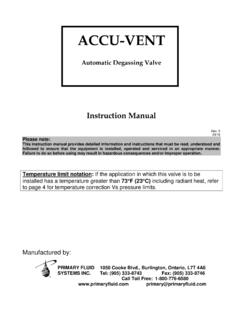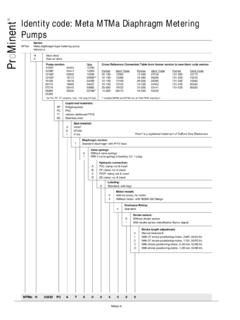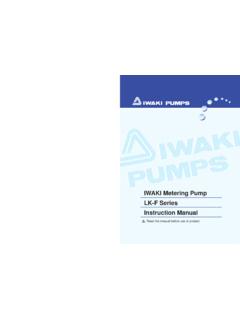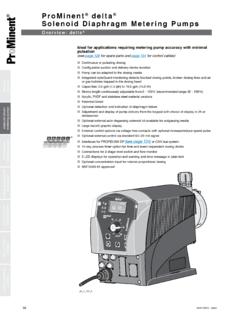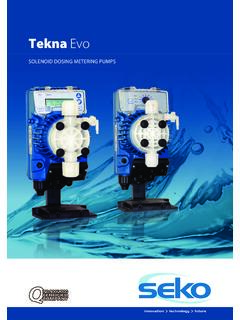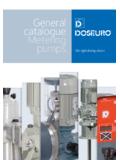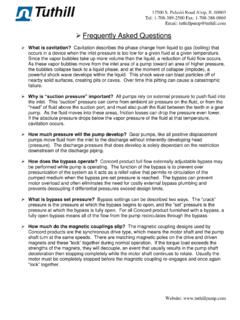Transcription of TOP VALVE - Primary Fluid
1 Instruction Manual 01/2013 Rev. 5 Manufactured by: TOP VALVE Pat. #5,857,486 & 5,944,050 Back Pressure and Pressure Relief valves TEMPERATURE LIMIT NOTATION: If the application in which this VALVE is to be installed has a temperature greater than 73 F (23 C) including radiant heat, refer to page 11 for temperature correction vs. pressure limits. PLEASE NOTE: This instruction manual provides detailed information and instructions that must be read, understood and followed to ensure that the equipment is installed, operated and serviced in an appropriate manner. Failure to do so before using may result in hazardous consequences and/or improper operation. NOTE: See Gauge Installation Instructions before removal of gauge plug to avoid thread damage. (Gauge port is optional) Primary Fluid SYSTEMS INC. 1050 COOKE BLVD., BURLINGTON, ON. CANADA L7T 4A8 TEL :(905)333-8743 FAX:(905)333-8746 1-800-776-6580 Toll Free 1-800-776-6580 email: 2 I N D E X INTRODUCTION.
2 3 Special Features of TOP VALVE .. 3 Back Pressure VALVE .. 3 Back Pressure valves : Reason for Selection and Use .. 4 Pressure Relief valves .. 4 Pressure Relief valves : Reason for Selection and Use .. 4 Installation and Maintenance of Back Pressure valves .. 4 Installation and Maintenance of Pressure Relief 5 Gauge Installation Instructions: (When ordered with VALVE only) .. 5 Manual Air Release .. 6 Typical Installations .. 7 ALL New Clamping Device for TOP VALVE , Back Pressure and Pressure Relief valves .. 8 Exploded Parts View Back Pressure & Pressure Relief VALVE .. 9 Dimensions Top VALVE Back Pressure .. 10 Dimensions Top VALVE Pressure Relief .. 10 Flow Rates .. 11 Temperature Correction Factors: Thermoplastics .. 11 LIMITED WARRANTY .. 12 Toll Free 1-800-776-6580 email: 3 INTRODUCTION The following instructions are to provide information on the Installation, operation and maintenance of TOP VALVE , 150# rated diaphragm style Back Pressure and Pressure Relief valves , manufactured by Primary Fluid Systems Inc.
3 The valves are designed to improve the performance and safe operation of most pumps used for metering applications. Various materials of construction are available dependent on the requirements of the application and the type of fluids being transferred. The VALVE (s) are factory set at 50 PSIG with a field adjustment range of 15-150 PSIG*. Other factory set pressure ranges (within the range of the VALVE ) are available upon request. Special Features of TOP VALVE PVC, PP, TFE, CPVC, PVDF, Hastelloy C, Alloy 20 or 316 S/S wetted construction PTFE laminated to EPDM backer diaphragm Turn down handle limits pressure to 150 PSIG Handle shaped for ease of adjustment Color-coded handles indicate size at a glance (Optional) Built-in matching material gauge port plug is easily removed for gauge option Rectangular shape for ease of installation Specially designed spring provides consistent pressure adjustments through the range (15-150 PSIG*) VALVE top specially designed for mounting clamp to help reduce pipeline stress when required Built-in downstream manual air release, for ease of pump priming Built-in anti-siphon *Pressures under 15 PSIG require rubber elastomeric diaphragm.
4 Back Pressure VALVE Diaphragm Back Pressure valves serve two Primary functions. The first is to provide a constant discharge pressure on the pump, which improves the performance, efficiency and consistency of the delivered volume. Secondly, the VALVE performs as an anti-siphon mechanism against positive or negative pressures in the downstream line. The VALVE is designed to allow for the venting of air into the downstream pipeline. This provides for easier priming of metering pumps that function under a suction lift. This is accomplished by a simple adjustment of the handle. The VALVE is available with an optional gauge port, pre-plugged at the factory or can be ordered complete with gauge to suit application. This eliminates the need to install extra fittings in the line to accommodate the addition of a gauge for the purpose of reading and setting of pressure. CAUTION: The gauge port is solely for the installation of the gauge and must not be used for the bleeding or venting of the system.
5 Improper operation of the VALVE and/or hazardous consequences could result. (see gauge installation instructions) Toll Free 1-800-776-6580 email: 4 Back Pressure valves : Reason for Selection and Use metering pumps having an atmospheric discharge system pressure of less than 20 psi and will benefit from the installation of a back pressure control VALVE . metering pumps in general require downstream back pressure to ensure smoother function of the discharge check assemblies, which enhances the accuracy of the discharge flow. Pressure Relief valves Diaphragm Pressure Relief valves are designed to relieve excess line pressure that exceeds the set pressure of the VALVE . This protects the system piping from overpressure that could result in hazardous leakage and/or damage to the pump and other system components. The Pressure Relief valves are normally recommended to be set between 5 and 10 PSIG above the system operating pressure.
6 The VALVE is of an in-line flow through design with bottom NPT relief port for piping back to supply tank or feed side of pump. The VALVE is available with an optional gauge port, pre-plugged at the factory or can be ordered complete with gauge to suit application. This eliminates the need to install extra fittings in the line to accommodate the addition of a gauge for the purpose of reading and setting of pressure. Pressure Relief valves : Reason for Selection and Use When using motor driven metering pumps, a pressure relief VALVE should always be installed on the downstream side of the pump to protect the system from over pressure which can cause pipe leakage and/or rupture. Installation and Maintenance of Back Pressure valves Back pressure control valves are installed on the discharge line of the pump. The VALVE should be located within a 2 (two)-foot distance of the pump discharge to ensure check VALVE seating. When pumping to a process line without an injection VALVE , the back pressure VALVE should be installed as close as possible to the injection point to prevent siphoning.
7 When used in conjunction with a pressure relief VALVE , always locate the back pressure VALVE on the downstream side of the relief VALVE . CAUTION: The gauge port is solely for the installation of the gauge and cannot be used for the bleeding or venting of the system. Improper operation and/or hazardous consequences could result. (see gauge installation instructions) Toll Free 1-800-776-6580 email: 5 The VALVE is supplied from the factory pre-set at 50 psig. To increase the pressure setting, back off the lock nut located beneath the colour coded handle. Turn the handle clockwise to increase pressure setting or counter clockwise to reduce pressure setting. Approximately one (1) full turn of the handle is equal to 10 psig. If maintenance is required on the VALVE : 1. Ensure that the VALVE is properly isolated from the line, not under pressure and properly flushed of chemical before proceeding to disassembly.
8 2. Turn knob on the top of VALVE , counterclockwise until all spring pressure is released before proceeding to undo retaining nuts, to remove top of VALVE for diaphragm replacement. 3. All working components ie. diaphragm, spring can be accessed by removing the four retaining nuts located on the top of the VALVE (item # 9 of parts breakdown). 4. When replacing the diaphragm, ensure the PTFE coated side of the diaphragm is facing down when viewed from the top of the VALVE . The installed diaphragm also functions as the body seal. (Torque nuts to 55 inch pounds when reassembling ) Installation and Maintenance of Pressure Relief valves Pressure relief valves are installed on the discharge line of a pump and should be located as close as possible to the metering pump. The VALVE is of an in-line flow through design with a bottom NPT relief port for piping back to the supply tank or feed side of the pump. Never install shut-off/isolation valves between pump discharge and in-line pressure relief valves .
9 When using in conjunction with a back pressure control VALVE , always install back pressure VALVE downstream of pressure relief VALVE . The relief port on the pressure relief VALVE should be piped back to the feed tank or suction side of the pump (see typical installation schematics). Gauge Installation Instructions: (When ordered with VALVE only) For the convenience of pressure setting and reading, there is an optional plugged gauge port provided, if the VALVE has not been ordered complete with gauge. Important: use a TORX style # T-45 wrench or screwdriver only to remove plug from plastic valves . Any other tool will strip the body of the plug and require an extractor to remove the threaded plug. CAUTION: The plastic VALVE bodies have standard NPT threads, which are tapered. When installing pipe into the body, hand tighten only to avoid cracking. CAUTION: Before removing the gauge port plug to install a gauge, ensure that the discharge line is not under pressure and lines are flushed with water prior to proceeding.
10 Ensure that the gauge you are using is chemical resistant to the Fluid before installing. Toll Free 1-800-776-6580 email: 6 Manual Air Release The VALVE is shipped with a factory set pressure of 50 psig. The diagram to the left shows a cut away view of the position of the diaphragm on the seat. To adjust the VALVE to relieve air or gas downstream: 1. Back off lock nut located beneath the colour coded handle. 2. Turn handle counter clockwise until approximately 1 inch of thread is exposed. 3. At this adjustment, the spring has relieved all tension from the diaphragm allowing air or gas to be vented downstream. Toll Free 1-800-776-6580 email: 7 Typical Installations The installations below are typical installation examples only. Consult your Engineering Department for the appropriate installation for your application or call the factory for advice.
